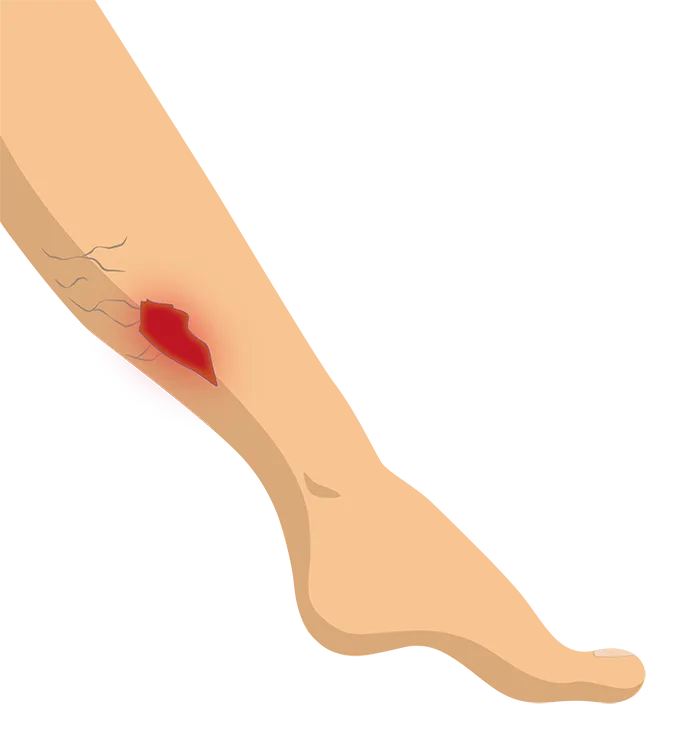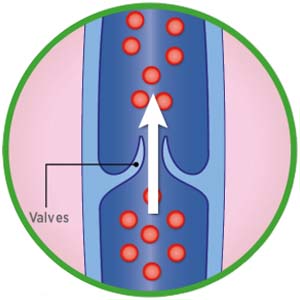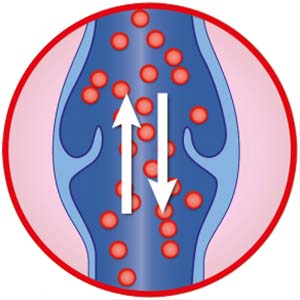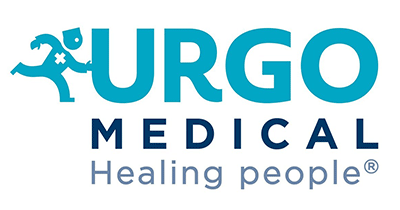
What is a leg ulcer ?
Leg ulcers are chronic wounds located on the lower thirds of the leg (under the knee). The most common cause is poor blood circulation, particularly the inability of the veins to return deoxygenated blood from the legs back to the heart. Other causes or risk factors include prolonged pressure on an area (such as long-term lying in bed in one position), poorly managed diabetes, high cholesterol, smoking, dietary problems and poor arterial circulation.
Leg ulcers can be:
- Venous leg ulcers : related to poor venous circulation. The wound is superficial in most cases, with inflamed, uneven edges. It is painful and mainly located around the ankle.
- Arterial leg ulcers : related to poor arterial circulation. These wounds may start out as a small cut with uneven edges on the leg or foot/toes and may progressively become deeper. These wounds are usually very painful.
- Mixed leg ulcers: related to poor arterial and venous circulations. Signs of a venous ulcer and an arterial ulcer are present at the same time.
How does a venous ulcer form?
A venous leg ulcer is the sign of chronic venous insufficiency which prevents the blood flowing normally in the veins of the leg. When blood flow is blocked, the blood stagnates in the leg veins causing tissue damage and skin breakdown.

Normal Vein
The veins allow blood to return to the heart. When you walk or exercise muscles contract to pump blood in the right direction. One-way valves stop blood from travelling backwards in the vein.

Damaged Vein
When veins are damaged the one-way valves that stop blood from travelling backwards in the vein stop working. The pooling of blood stretches and distorts the vein. This results in damage to the tissue surrounding the vein – the skin is no longer correctly oxygenated and becomes fragile. There is high risk of an ulcer forming from slight trauma or even spontaneously.
Various factors can increase the risk of chronic leg ulcerations, including:
- History of varicose veins or deep vein thrombosis
- Age
- Arterial disease
- Cigarette smoking
- Being overweight/obesity
- Lack of physical exercise or bed-bound
Treatment of venous leg ulcers
It is very important to consult your doctor as soon as you notice a leg ulcer.
Treatment includes:
- Cleaning the wound to remove the dead tissue
- Specialised dressings – dressing are changed less often these days, because frequent dressing changes remove healthy cells as well.
- Occlusive (air and water-tight) dressings are often used as ulcers heal better when they are covered.
- Compression treatment – boosts internal pressure, using either elasticised bandages or stockings. This is particularly effective if multiple layers are used.
For a mixed leg ulcer (both venous and arterial), compression can be used but it is looser than for a venous ulcer. Compression treatment is not used for arterial ulcers.
Avoiding relapse
To reduce the risk of developing other ulcers you should make sure any underlying conditions that contributed to your leg ulcer are addressed and treated.
These may include:
- treatment for varicose veins
- quitting cigarettes
- improving our diet
- taking regular exercise
You should also:
- avoid crossing your legs whilst sitting down
- avoid hot baths
- keep you leg elevated above the level of your heart where practical
- wear your compression socks
- wear comfortable, non-slip shoes
- regularly moisturise your skin
- prevent weight gain

